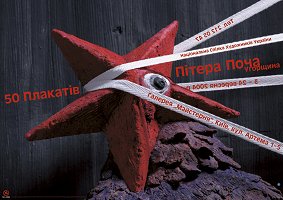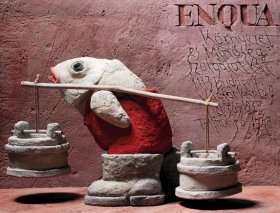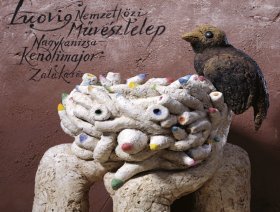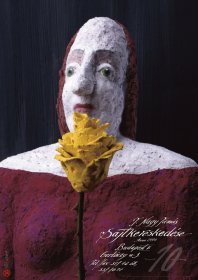
Exhibition poster: 50 Plakata Pitera Pocha

23.10.'56. / 1989
1989, offset, 98.5 x 67.5 cm
Client: Peter Pocs, Kecskemet

ENQUA
Environment & Quality Service Ltd.
2003, offset, 84.5 x 111.5 cm

LUDVIG International Artists' Colony
2003, offset, 84.5 x 111.5 cm

Tamás T. Nagy's Cheese Trade Company
2004, offset, 120.5 x 85 cm
Gallery Maysternia, National Union of Artists of the Ukraine, Artema str 1-5, Kyiv (UA)
3 - 24 September, 2004
A catalogue with all 50 posters will be published on the occasion.
Peter Pocs and Various Aspects in Modern Poster Design
Every time I attend the opening of a poster exhibition I hear the same questions. Where is the modern Ukrainian poster? Does it exist at all? Does the poster have its future?
The Ukrainian poster, be it real or potential, has undergone the same development trends as any of its European counterparts. The present day freedom of information flow as well as the technical equality of rights allow us to make such claims. In the previous century the poster lived in the streets and catered for all the needs of information of the society advertising ideas as well as goods at the same time. Ideas were mostly advertised in the USSR, as the motherland of the total deficit had nothing more to promote, whereas the latter ones were typical of the rest of the world. The intellectual product advertising poster is in the process of development: it is the theatrical and cinematographic poster, the one to be exhibited. These trends have already become characteristic of the whole Europe. In the era of communism censorship influenced the literary component of the poster, though it permitted some degree of freedom in the manner of expression. In the sixties, for example, a generally accepted permission was granted for formal ways of expression in the Soviet-Ukrainian poster and only in the poster art, which was provoked by the mostly primitive technologies, which at the same time coincided with the then contemporary minimalist trends in the world.
The early 21st century poster (here it should be noted that modern billboard advertisement is not to be treated as a kind of poster art) moved to galleries and walls of sophisticated interiors, on the one hand serving the lovers of the antique hobbies and on the other hand trying to satisfy exquisite tastes of these days' customers in those rare cases when they appeal to the complicated multilevel image. The poster used to be the mouthpiece of masses but it turned into intellectuals' elite aesthetic oasis. It is a quite unexpected metamorphosis though the transformation has already taken place and we have witnessed that. High-tech intruded again. The television, the Internet, the radio and the possibility to print large-scale plotters assumed the functions of straightforwardness, familiarity and accessibility, they creep in through our windows, in cars speeding away, on TV and computer screens. They never stop, not even for a single minute, but allure and obtrude leaving no space to complex reflections evoked by modern art.
The situation has completely changed. Verbal stereotypes like "as short as the poster", "simple as a poster" or "the poster's rough language", which were used as epithets of the poster in the middle of the previous century, are not suitable anymore. Today's poster is complex, multileveled and sometimes even demanding due to its subtle plastic of the sheet. These very qualities appeared to be the least needed ones, as they prevent the fast spreading of the information about products modern advertising relies upon.
The poster has changed with the vogue and style of the epoch, developing alongside printing techniques. Born at the dawn of Art Nouveau, it benefited from lithography and bravely tried constructivism. As any other applied art, it was resolute to use new techniques a the photocollage of the thirties relied on the development of photography and appearance of zincography, while the realism of the poster of the fifties' is considerably predetermined by the offset printing invention. The fact that the poster is the child of the economic progress sounds a banal truism. But the very time when the latest techniques granted the poster artist a computer and thus made him almighty the poster as an art began to disappear. It is average PhotoShop users but not artists who select and compile pictures and thereby create not a placard as a piece of art but an advertisement of a product, promoting brands against romantic landscapes instead of promoting ideas.
But still there are artists and painters devoted to poster art. We have been exhibiting posters by prominent present day European artists in our gallery for several years. Here is Peter Pocs, Hungary. We see him in his prime, when experience and talent merge. He is a master known worldwide, who started his creative activity in the golden age of the poster, in the seventies of the previous century. The Polish school of poster artists considerably influenced PScs and it seems to me that the most important lesson he learnt was the necessity to show his own style.
Peter Pocs's brand is a special poster a a sculpture to be photographed. His manner is so much original that it is easily recognized in the streets, from whatever distance, as well as in exhibition halls. Even without examining what is happening in the poster we can tell the author's name. They are really happening, these metaphoric transformations in Peter Pocs's sculpture poster. Small men and objects, sad and unskillful, sculptured in the art of the primitive style, occupy the scene built in a very inventive manner. The artist's great success lies in the persuasiveness and sincerity of this style. The sophisticated design of the sculpture and the light set while photographing are the unquestionable evidence of high level professionalism. These images have their prehistory one may guess and also the future life that goes on outside the visible frame of the poster. If one could estimate the artist's creative activity by calculating the number of associative images a spectator finds, Peter Pocs's posters would get the highest mark. With no doubt, the placard titled '56.10.23./1989', which depicts the red star in a mouse trap, is one of these. Had the red star not been cut out of raw meat, the image might not have evoked any particular interest. And so much truth and horror, so many myths invented are behind that one can only bow before the poster artist's skill. The artist who thinks and not merely designs, sculptures and feels.
Let's open Peter Pocs's catalogue, where the customer's name together with the title and technique is also indicated. What the poster will be and whether it will be at all depends much upon the customer. Who is the 'ideal customer' today? It is somebody who, having respect for the 'poster', will appeal to the artist. It is a person who treats the poster as irony and self-criticism, an indispensable part of the perception of the world, not merely as a frivolous hint. The artist often embodies the customer's ideas and feelings in his work, not anybody else's. It is him, the customer, who is present as the invisible co-author of the poster. It is the customer whose visual culture allows the artist to express an idea in his individual manner.
The artist, the available printing techniques and the customer are the elements that have been required for poster creation for more than one hundred years already. All the three components exist in the Ukraine, without any doubt; now they only need to meet.
Irena Veshtak-Ostromenskaja
Artist and Director of Gallery "Maysternia"